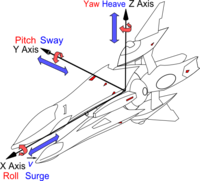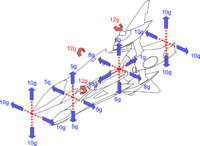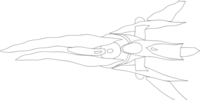Mechanical stresses on ships
Mechanical stresses on ships can be caused by ship motions, internal cargo or liquids, and environmental induced.
Ship motions[edit | edit source]
- Main article: Ship motions
| Linear motion | Rotational motion |
| Surging is motion along the longitudinal axis. | Rolling is motion around the longitudinal axis. |
| Swaying is motion along the transverse axis. | Pitching is motion around the transverse axis. |
| Heaving is motion along the vertical axis. | Yawing is motion around the vertical axis. |
Acclerations[edit | edit source]
The outwardly directed centrifugal accelerations brought about by any rotational motion differ significantly based on the size and axis of the ship. This accordingly applies to yawing, pitching and rolling. Rolling being the least impacting, yet, can still be extreme on large ships.
Acceleration can be due to the ship accelerating with its thrusters or the ship being tugged by another or by a gravity well, but also by any other motion.
The acceleration experienced on board differs depending on the location. The further away from the centre of mass the larger the acceleration experienced.
Collision[edit | edit source]
Slamming can occur at any point of the ship when hit by dense solar wind or cloud or even ship to ship collision.
Acoustic Vibration[edit | edit source]
Machinery and any applied force inside the ship can create vibration. Each one may not be much of concern. However, when the frequency of its oscillations matches the system's natural frequency of vibration leading to mechanical resonance can cause catastrophic structural failure. Acoustic vibration and oscillation can occur all over the ship in any direction. As a result the ship jigs and bends until the breaking point
Cargo[edit | edit source]
- See also: Stowage plan for ships
A cargo container placed on any surface or attached to any rack will exert its weights when under gravity or acceleration. A floor is typically rated for a certain amount of weight per square meter area. When stacked that resulting weight is not necessarily apparent. Due to motion all containers have to be secured. For the same reason containers must comply with motion and crash requirements.
| Type of package | Acceleration factors | ||
|---|---|---|---|
| ' | longitudal | lateral | vertical |
| standard | 10g | 6g | 4g |
| fuel | 12g | 8g | 8g |
| AM | 20g | 12g | 10g |
| ' | ' | ' | ' |
| Ship size | rated floor loading t/m2 |
acceleration g |
loaded stress t/m2 |
| boat | 2 | 10 | 20 |
| small ship | 5 | 5 | 25 |
| medium ship | 10 | 4 | 40 |
| large ship | 20 | 3 | 60 |
| ' | ' | ' |






